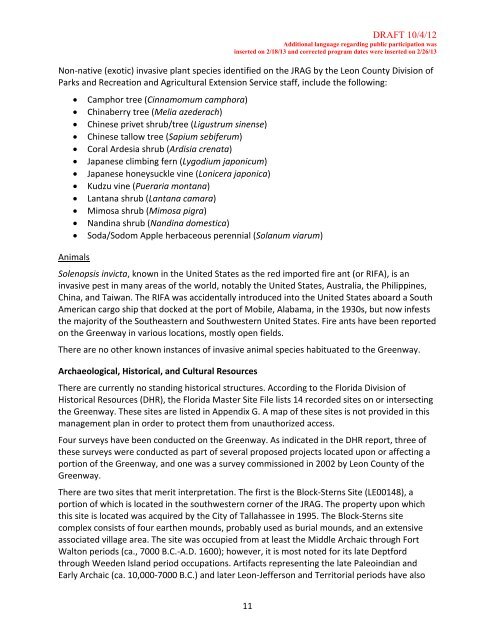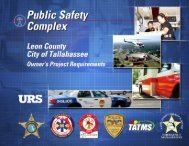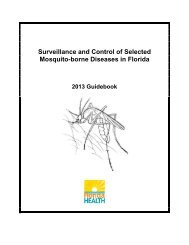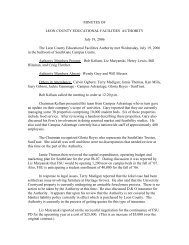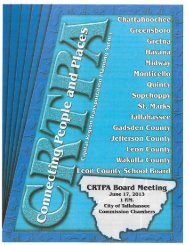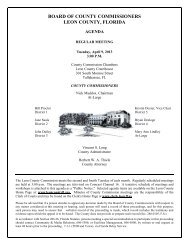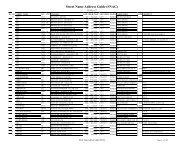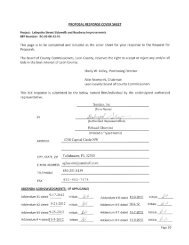J.R. Alford Greenway - Leon County
J.R. Alford Greenway - Leon County
J.R. Alford Greenway - Leon County
You also want an ePaper? Increase the reach of your titles
YUMPU automatically turns print PDFs into web optimized ePapers that Google loves.
DRAFT 10/4/12<br />
Additional language regarding public participation was<br />
inserted on 2/18/13 and corrected program dates were inserted on 2/26/13<br />
Non‐native (exotic) invasive plant species identified on the JRAG by the <strong>Leon</strong> <strong>County</strong> Division of<br />
Parks and Recreation and Agricultural Extension Service staff, include the following:<br />
Camphor tree (Cinnamomum camphora)<br />
Chinaberry tree (Melia azederach)<br />
Chinese privet shrub/tree (Ligustrum sinense)<br />
Chinese tallow tree (Sapium sebiferum)<br />
Coral Ardesia shrub (Ardisia crenata)<br />
Japanese climbing fern (Lygodium japonicum)<br />
Japanese honeysuckle vine (Lonicera japonica)<br />
Kudzu vine (Pueraria montana)<br />
Lantana shrub (Lantana camara)<br />
Mimosa shrub (Mimosa pigra)<br />
Nandina shrub (Nandina domestica)<br />
Soda/Sodom Apple herbaceous perennial (Solanum viarum)<br />
Animals<br />
Solenopsis invicta, known in the United States as the red imported fire ant (or RIFA), is an<br />
invasive pest in many areas of the world, notably the United States, Australia, the Philippines,<br />
China, and Taiwan. The RIFA was accidentally introduced into the United States aboard a South<br />
American cargo ship that docked at the port of Mobile, Alabama, in the 1930s, but now infests<br />
the majority of the Southeastern and Southwestern United States. Fire ants have been reported<br />
on the <strong>Greenway</strong> in various locations, mostly open fields.<br />
There are no other known instances of invasive animal species habituated to the <strong>Greenway</strong>.<br />
Archaeological, Historical, and Cultural Resources<br />
There are currently no standing historical structures. According to the Florida Division of<br />
Historical Resources (DHR), the Florida Master Site File lists 14 recorded sites on or intersecting<br />
the <strong>Greenway</strong>. These sites are listed in Appendix G. A map of these sites is not provided in this<br />
management plan in order to protect them from unauthorized access.<br />
Four surveys have been conducted on the <strong>Greenway</strong>. As indicated in the DHR report, three of<br />
these surveys were conducted as part of several proposed projects located upon or affecting a<br />
portion of the <strong>Greenway</strong>, and one was a survey commissioned in 2002 by <strong>Leon</strong> <strong>County</strong> of the<br />
<strong>Greenway</strong>.<br />
There are two sites that merit interpretation. The first is the Block‐Sterns Site (LE00148), a<br />
portion of which is located in the southwestern corner of the JRAG. The property upon which<br />
this site is located was acquired by the City of Tallahassee in 1995. The Block‐Sterns site<br />
complex consists of four earthen mounds, probably used as burial mounds, and an extensive<br />
associated village area. The site was occupied from at least the Middle Archaic through Fort<br />
Walton periods (ca., 7000 B.C.‐A.D. 1600); however, it is most noted for its late Deptford<br />
through Weeden Island period occupations. Artifacts representing the late Paleoindian and<br />
Early Archaic (ca. 10,000‐7000 B.C.) and later <strong>Leon</strong>‐Jefferson and Territorial periods have also<br />
11


